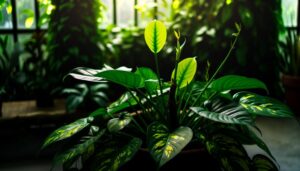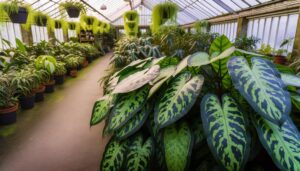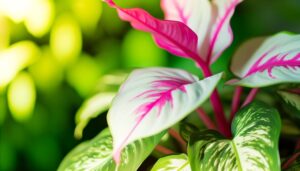What Should I Do if My Heartleaf Philodendron Has New Growth?
New growth on your Heartleaf Philodendron indicates strong health. To maintain this, make sure the soil remains consistently moist but well-draining, allowing the top inch to dry slightly between waterings.
Place the plant in bright, indirect sunlight to prevent leggy growth while avoiding direct sun that can scorch the leaves. Regularly inspect for pests, particularly on leaf undersides and stem junctions, to manage infestations promptly.
Use humidifiers or frequent misting to maintain essential humidity. Consider repotting if the roots are bound and prune during the growing season to encourage bushier growth.
Further detailed care measures will enhance its strength.
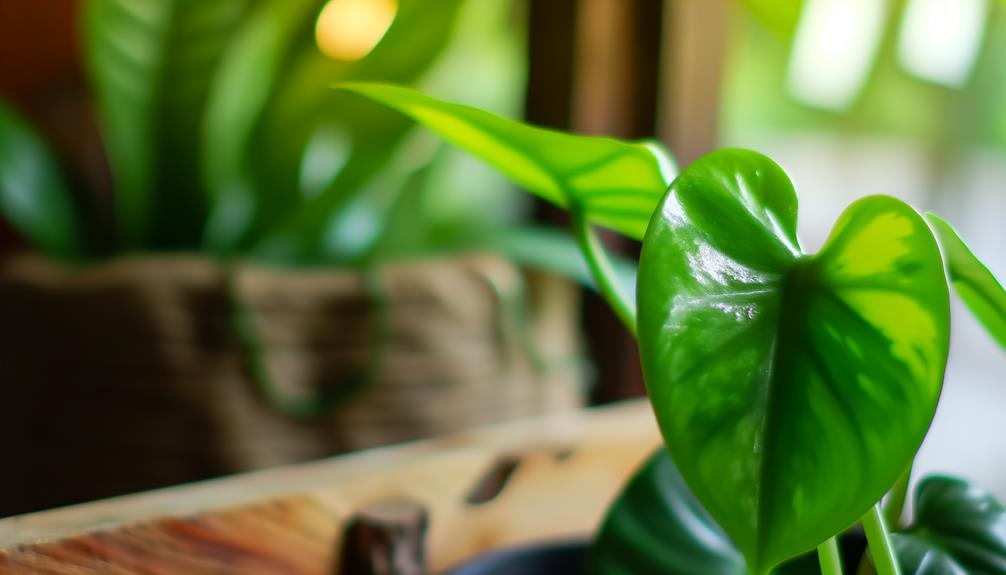
Key Takeaways
- Ensure consistent watering by keeping soil moist but allowing the top inch to dry slightly between waterings.
- Place the plant in bright, indirect sunlight to support robust new growth without causing leaf scorch.
- Regularly inspect for pests on leaf undersides and stem junctions to prevent infestations that could harm new growth.
- Maintain high humidity levels using a humidifier, frequent misting, or grouping plants together.
- Prune as needed to encourage bushier growth and remove any damaged or leggy parts for a healthier plant.
Assess Watering Needs

Evaluating the watering needs of a Heartleaf Philodendron is essential for promoting ideal new growth and preventing potential issues such as root rot or dehydration. This tropical plant thrives in consistently moist but well-draining soil. Utilize a soil moisture meter or manually check the top inch of soil; it should be allowed to dry slightly between waterings.
Overwatering can lead to root rot, characterized by yellowing leaves and a mushy root system, while underwatering may cause leaf curling and browning edges. Employ room-temperature, non-chlorinated water to avoid shock to the plant. Adjust watering frequency based on seasonal variations, reducing in winter when growth slows.
Proper hydration management is critical for ensuring the plant's health and vigorous new growth.
Monitor Light Conditions
Optimizing ideal light conditions is crucial for the robust growth of a Heartleaf Philodendron, which thrives in bright, indirect sunlight. Proper light management can greatly influence its health and vigor.
Too much direct sunlight can cause leaf scorch, while insufficient light may lead to leggy growth and pale foliage. To optimize light exposure, consider the following:
- Positioning: Place the plant near an east or north-facing window.
- Artificial Lighting: Utilize fluorescent lights if natural light is insufficient.
- Rotation: Rotate the plant periodically to guarantee even light distribution.
- Monitoring: Use a light meter to make sure the plant receives 200-400 foot-candles of light.
Check for Pests
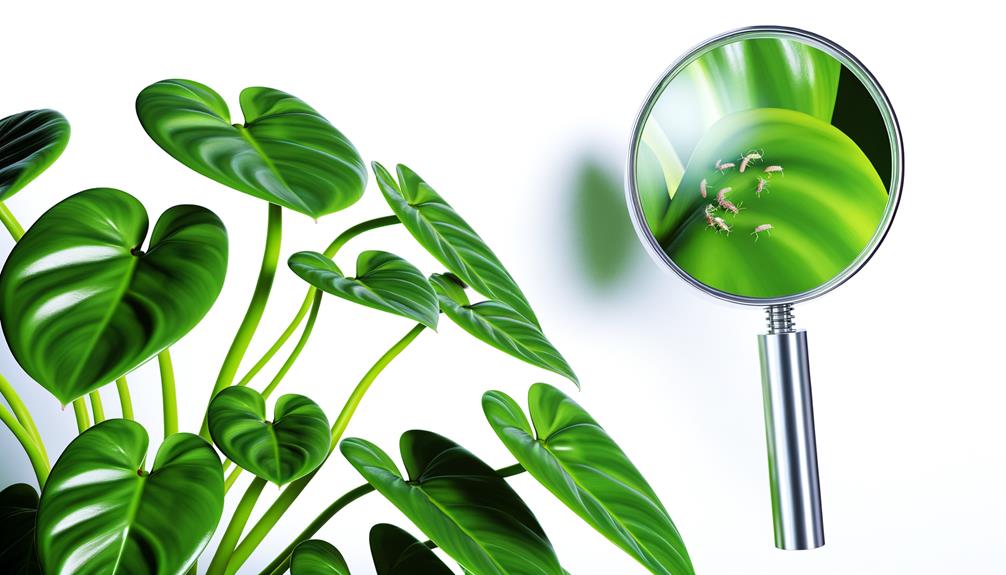
To maintain the health of your Heartleaf Philodendron, it is important to conduct regular inspections for pests. Begin by examining the undersides of the leaves, where common pests such as spider mites and aphids frequently reside.
Additionally, inspect the stem junctions and monitor the soil surface for any signs of infestation or unusual activity.
Inspect Leaf Undersides
Examining the undersides of heartleaf philodendron leaves is vital for identifying potential pest infestations that could hinder new growth and overall plant health. Pests such as aphids, spider mites, and mealybugs often reside on the leaf undersides, where they feed on plant sap, causing damage and stunting growth. Regularly inspect these areas to guarantee early detection and prompt management.
Key indicators to look for include:
- Discoloration: Yellow or brown spots may indicate pest activity.
- Webbing: Fine, silky webs are suggestive of spider mites.
- Residue: Sticky honeydew or sooty mold can indicate aphid or mealybug presence.
- Movement: Tiny insects or larvae moving on the leaf surface.
Examine Stem Junctions
In the intricate network of a heartleaf philodendron, stem junctions often become hotspots for pest activity, where insects such as scale and thrips can hide and proliferate. These areas should be meticulously examined because pests can impede new growth and cause extensive damage.
Utilize a magnifying glass to detect minute pests effectively. Look for tiny, discolored bumps or moving specks, indicative of scale insects and thrips, respectively. Clean these junctions with a cotton swab dipped in rubbing alcohol to remove pests.
Regular inspection and immediate action are crucial to maintain the plant's health. By addressing infestations early, you guarantee the philodendron's new growth thrives, free from debilitating pest interference.
Monitor Soil Surface
Scrutinizing the soil surface is imperative, as it often harbors pests like fungus gnats and mites that can disrupt the philodendron's root system and impede new growth. Regular inspections help in early detection and timely intervention.
Use magnification tools to spot tiny invaders and consider the following measures:
- Sticky Traps: Place yellow sticky traps on the soil surface to capture flying pests like fungus gnats.
- Soil Moisture Monitoring: Keep soil slightly dry to deter moisture-loving pests.
- Neem Oil Solution: Apply neem oil to the soil to naturally repel or kill harmful insects.
- Beneficial Nematodes: Introduce nematodes to the soil to biologically control pest populations.
These proactive steps can greatly enhance the health and growth of your Heartleaf Philodendron.
Optimize Humidity Levels
To achieve best growth for the Heartleaf Philodendron, maintaining appropriate humidity levels is essential.
Regular use of humidifiers can effectively increase ambient moisture, while misting the plant frequently helps to directly hydrate its foliage.
Additionally, grouping plants together can create a microenvironment that naturally elevates humidity levels, promoting healthier and more robust new growth.
Use Humidifiers Regularly
Maintaining ideal humidity levels, ideally between 60% and 80%, is important for the healthy growth of Heartleaf Philodendrons, and using humidifiers regularly can effectively achieve this. Humidifiers help to replicate the plant's natural tropical environment, ensuring best moisture availability. They are particularly beneficial in indoor settings where air conditioning or heating systems can greatly reduce ambient humidity.
Key considerations when using humidifiers include:
- Consistency: Guarantee the humidifier is used consistently to maintain stable humidity levels.
- Placement: Position the humidifier near the plant but not directly on it to avoid excessive moisture buildup.
- Maintenance: Regularly clean the humidifier to prevent mold and bacteria growth.
- Monitoring: Use a hygrometer to track humidity levels accurately, adjusting the humidifier settings as needed.
Mist Plant Frequently
Regular misting of the Heartleaf Philodendron can greatly enhance ambient humidity around the plant, promoting ideal growth conditions. This practice is particularly beneficial in environments with low natural humidity, where the plant may suffer from desiccation.
Misting should be performed using distilled or filtered water to avoid mineral buildup on the leaves. Aim to mist the plant in the morning, allowing the foliage to dry throughout the day and reducing the risk of fungal infections. A fine misting bottle is recommended to guarantee an even, light application.
Consistency is key; misting daily or several times a week can help maintain the humidity levels that support robust new growth and overall plant health.
Group Plants Together
In addition to regular misting, grouping Heartleaf Philodendrons with other humidity-loving plants can greatly enhance the microenvironment, creating a localized humid zone that supports ideal growth. This method leverages the natural transpiration process, where plants release moisture into the air, collectively raising humidity levels.
Optimal humidity is essential for the Heartleaf Philodendron, particularly when it is producing new growth, as it prevents leaf edges from drying and promotes vigorous development.
Benefits of grouping plants together include:
- Increased Humidity: Enhanced moisture levels around the plants.
- Microclimate Creation: Establishment of a stable environment with consistent conditions.
- Disease Prevention: Reduced risk of pests and diseases due to healthier plants.
- Enhanced Aesthetics: More visually appealing arrangement enhancing overall decor.
Consider Repotting
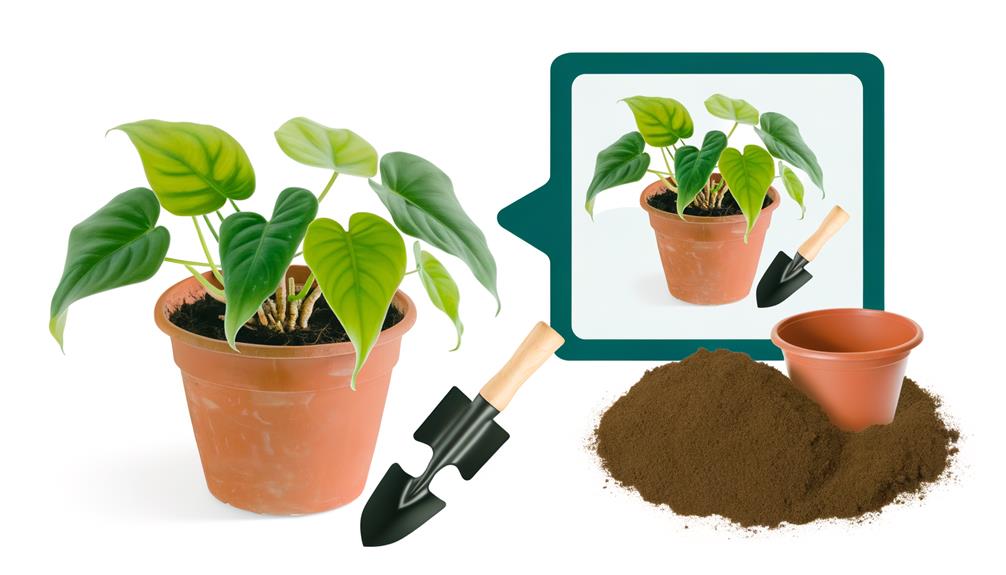
When the Heartleaf Philodendron exhibits signs of vigorous new growth, it may be wise to evaluate the root system for potential repotting to achieve peak plant health. Repotting provides the plant with fresh soil, which is essential for nutrient uptake and root expansion. Choose a pot that is 1-2 inches larger in diameter than the current one to prevent root congestion.
Here's a guideline for repotting:
| Step | Action | Purpose |
|---|---|---|
| 1. Preparation | Gather new pot, fresh soil, and tools | Ensure all materials are ready |
| 2. Inspection | Check root system for bound roots or decay | Identify health of roots |
| 3. Repotting | Transfer plant to new pot, fill with soil | Provide space for growth |
Careful repotting supports continued healthy growth and liveliness.
Prune Wisely
Trimming the Heartleaf Philodendron is an essential practice to manage its growth, enhance its aesthetic appeal, and maintain peak health. Pruning encourages bushier growth, prevents legginess, and helps remove any diseased or damaged leaves.
To achieve best results, consider the following guidelines:
- Tools: Use sterilized, sharp pruning shears to prevent the spread of pathogens.
- Timing: Prune during the growing season, typically spring or early summer, when the plant can recover quickly.
- Technique: Cut just above a leaf node to encourage new growth at that point.
- Frequency: Regularly inspect the plant and prune as needed to maintain desired shape and health.
Adhering to these principles ensures a flourishing, visually appealing Heartleaf Philodendron.
Conclusion
To sum up, the appearance of new growth in a heartleaf philodendron requires a comprehensive approach similar to a physician diagnosing a patient.
Evaluating watering requirements, observing light conditions, inspecting for pests, optimizing humidity levels, contemplating repotting, and pruning carefully are all crucial steps.
Each element interacts to guarantee the plant's health and vitality, akin to a symphony where every instrument must be finely adjusted for harmonious performance.
Proper focus on these factors will promote vigorous growth and overall plant health.


